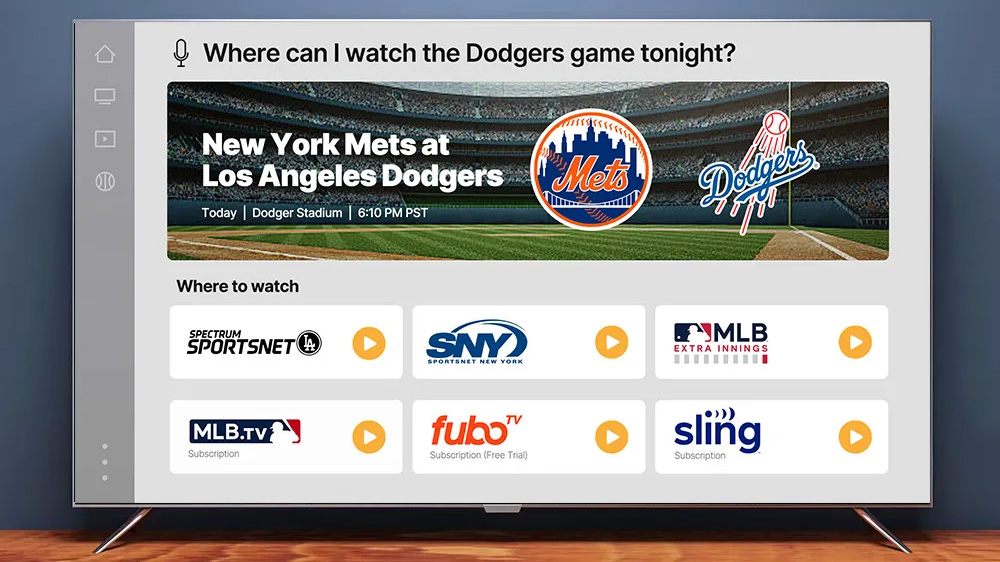Live sports remain one of the few appointment-viewing experiences left in today’s on-demand TV world. For many fans, however, simply finding the game they want to watch has become an increasing challenge. As sports rights have fragmented across an ever-expanding list of services and channels, even the most dedicated fans often spend more time searching for coverage than actually watching it.
A recent Gracenote survey of streaming consumers found, for example, that the average viewer now spends 14 minutes looking for something to watch, and one-quarter say they often know what they want to watch but still can’t find it. Why? Because there is no universal guide for the growing web of disparate video distribution across CTV.
For publishers, including streaming services and smart TV OEMs, that frustration represents both a problem and an opportunity. Those that best solve the problem of content discovery have an opportunity to become the destination where fans can easily find any game, on any service.

Fragmentation frustration
Given the massive appeal of live sports, every major sports league — and many individual teams — has its own mix of broadcast and streaming deals. This is contrary to how traditional programs air. Season five of Abbott Elementary, for example, airs on ABC before becoming available on streaming services. The rights to sports distribution, on the other hand, are far less straightforward.
To watch every game in an NFL season, for example, a fan has to have access to the NFL Sunday Ticket on YouTube TV, four broadcast stations, ESPN, Amazon Prime Video, Netflix, Peacock and the NFL Network. Interested in the Premier League? Fans need access to Peacock Premium, two linear channels (NBC and USA Network), Paramount+, ESPN+. Fragmentation is even more prevalent at the individual team level. Fourteen NHL teams, for example, have their own DTC networks, as do at least six NBA and two WNBA teams.
A similar story is emerging in other parts of the world. Currently, UEFA Champions League soccer matches are usually broadcast live on one or two channels per country. Earlier this month, however, news reports began to surface noting that UEFA will be targeting the global streaming giants in their next rights auction for 2027-2033.
This season, Amazon Prime Video gets the first pick of the Champions League games in Germany, Italy and the U.K., while other channels in those countries broadcast the rest. From 2027, there may be multiple free-to-air, pay TV and streaming companies broadcasting Champions League matches in almost every country in the world.

When you add free ad-supported streaming TV (FAST) channels, ESPN+, Fox One, and a host of new sports-focused services to the mix, fans don’t just need to hop between platforms and services to follow a single league or team—they need guidance to know where to find the games they’re looking for. FAST is somewhat of a new option for fans, but the amount of sports programming they offer has increased 11% this year. And what’s more, 38% of the sports programming in September was live competitions, up 5.5% from the previous month.
Delivering what fans want
For publishers, solving the discovery problem doesn’t mean owning more content. It means providing better access to it. After all, the better the experience you create for fans, the longer they stay. Importantly, 84% of streaming viewers say their overall enjoyment is tied to the user experience.
That’s why some media companies are beginning to bundle cross-platform programming from within their interfaces. DIRECTV Stream, for example, has begun integrating partner apps like Amazon Prime Video, ESPN, Peacock and Paramount+ directly into its UX. This approach allows subscribers to launch these apps from within the DIRECTV environment, keeping the viewer anchored in one consistent interface, rather than forcing them to bounce between apps. While this creates a consolidated view of a viewer’s services, it doesn’t point them to what they’re really looking for. That is where the real opportunity lies.

Delivering a seamless experience, complete with everything a sports fan wants, requires deep, cross-platform visibility into sports programming. Looking at the global landscape, there are more than 150 sports leagues/tours in over 50 countries worldwide. That’s where integrated video and sports metadata that links live games, events, related and shoulder programming, and imagery play a crucial role.
The value of solving the discovery challenge
Building this kind of holistic sports discovery layer benefits everyone in the value chain. Viewers get a better, less fragmented experience, and platforms retain engagement and reduce churn. And as sports continues to fragment across the CTV landscape, normalized metadata—inclusive of TV listings—provides advertisers with the necessary transparency to buy inventory at scale.
Ultimately, the viewer experience that a platform creates is a more sustainable differentiator than the exclusivity of any single game. In an age of fragmentation, discovery becomes the new frontier of competition, and metadata is the infrastructure that makes it possible.
Streaming has viewers captive in a fractured CTV landscape
Streaming viewers have become overwhelmed by choice and fragmentation. This sentiment is mounting, and it has a range of downstream effects.
The streaming paradox: More content has led to less satisfaction
Viewer frustrations are on the rise as streaming service congestion increases, highlighting opportunities for improved UX and content discovery.
Streaming service congestion is fueling an uptick in FAST channel engagement
As streaming options proliferate, engagement with FAST channels is on the rise, with news and sports becoming top genres.
